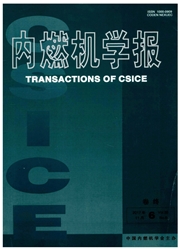

 中文摘要:
中文摘要:
在MULINBUMP复合燃烧系统多次脉冲喷油控制参数的优化过程中,利用一种高效全局智能寻优方法——微种群遗传算法,并结合发动机三维数值模拟程序KIVA,建立起一个发动机多参数优化模拟平台。为提高模拟精度对标准的KIVA程序进行了改进,引入KH—RT雾化模型、层流和湍流多重特征时间尺度燃烧模型、Han和Reitz传热模型以及Hiroyasu和Nagle碳烟排放模型来模拟柴油机多次脉冲喷雾、燃烧、壁面传热及排放过程,同时增添改进的Shell自燃模型来模拟着火过程。计算结果表明,采用改进的KIVA程序计算的喷雾贯穿距、缸内压力、着火时刻、燃烧放热率以及NOx和碳烟排放更接近试验结果;用改进的KIVA程序能够较好地模拟柴油机多次脉冲喷雾和燃烧过程,为进一步利用三维数值模拟计算来指导多脉冲喷油控制参数的优化奠定了基础。
 英文摘要:
英文摘要:
To optimize the multi-pulse injection parameters of MULINBUMP compound combustion system, a simulation technique for engine parameter optimization was developed by using the combination of a micro-genetic algorithm as highly effective optimization method and a three-dimensional CFD code based on KIVA. Some sub-models of the original KIVA code were modified, by introducing into the Kelvin- Helmbohz and Rayleigh-Taylor model for spray breakup, the multiple laminar and turbulent characteristic timescale combustion model, the heat transfer model of Han and Reitz, the Hiroyasu and Nagle soot model and the improved Shell auto-ignition model were added to the original KIVA, to improve the predictions of engine spray, ignition, combustion, gas/wall heat transfer and emissions. The predicted values were compared with the engine testing data. The results show good agreement with experimental data in jet penetration, in cylinder pressure, in ignition timing, in heat release, in NOx and soot emissions. The modified KIVA code could accurately predict the essential features of spray, ignition and combustion in a DI diesel engine based on the multi-pulse injection. This work established the foundation for optimizing the multipulse injection parameters of MULINBUMP compound combustion system using the simulation technique.
 同期刊论文项目
同期刊论文项目
 同项目期刊论文
同项目期刊论文
 A numerical study of cavitating flows in high-pressure diesel injection nozzle holes using a two-flu
A numerical study of cavitating flows in high-pressure diesel injection nozzle holes using a two-flu Chemiluminescence spectroscopic analysis of homogeneous charge compression ignition combustion proce
Chemiluminescence spectroscopic analysis of homogeneous charge compression ignition combustion proce Numerical investigation on relationship between injection pressure fluctuations and unsteady cavitat
Numerical investigation on relationship between injection pressure fluctuations and unsteady cavitat Experimental study of n-butanol additive and multi-injection on HD diesel engine performance and emi
Experimental study of n-butanol additive and multi-injection on HD diesel engine performance and emi 期刊信息
期刊信息
